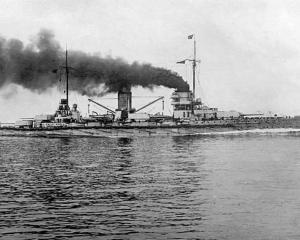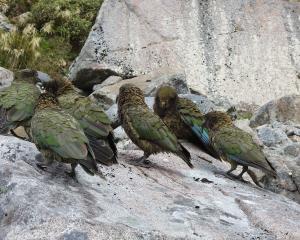Upbeat articles about jolly good things can be fairly tedious. The world is full of threats and alarms and who needs infotainment?
It can make one pause before penning an unreservedly positive note but sometimes it needs to be done if there's to be a balanced record.
A characteristic of the arts in this city is an enduring and still surprising underlying stream of excellence. Just when you think it must have petered out it springs up and shocks you pleasantly again.
As I write this the 15th iD Dunedin Fashion Week has yet to start but will be under way when this appears.
The 2014 Dunedin Heritage Re-use Awards were announced last Wednesday and the associated exhibition closed the same night but the ''reused'' buildings are still with us. And the director of the Otago Museum, Dr Ian Griffin, has announced his broad plans for the institution's future.
I attended the heritage awards presentation and was reminded of the second iD Fashion Week, the first held at the railway station. There was quite a long queue and quite a long wait, although I didn't find that frustrating.
I know some of the people involved in organising it and remember it being asked ''Why is it so hard in Dunedin?''. I don't know the answer but remember vividly the brilliance of the event.
Beyond its impressive staging there were also the clothes. You had to ask ''Where did this come from?''. The designers were not all unknown to me, but the effect of seeing so many of their productions together made one feel one was witnessing a phenomenon. I think it was and remains so.
It was an utter transformation from what was shown as fashion here, for example, in the 1970s. I think by any artistic measure it was not just different - fashion changes all the time - but a step change better.
The presentation of the heritage awards was the fourth since their inception. The city council's policy planner heritage, Dr Glen Hazelton, spoke and referred obliquely to the arduousness of staging them.
Mayor Dave Cull spoke and referred to his own and Cr Lee Vandervis' roles on a committee lying behind the awards and was very clear about the value of what the developers, designers, engineers and participating students had achieved.
The relevant buildings are markers and providers of the city's identity, character and amenity and fitting them out for new uses gives them better futures.
Mr Cull too referred to challenges and difficulties. When you work on old buildings things can happen which make you wonder why you are bothering at all.
The exhibition had photographs of the candidate projects and student designs for what might be attempted at the Athenaeum, free of the constraints of any budget or having to persuade the amiable owner Lawrie Forbes to actually undertake them.
Before the speeches started I had looked at the exhibition and most of the candidates were familiar. In fact, I have been on tours of some or otherwise seen their interiors.
The restored Cargill Monument, the nearby old Bank of New Zealand and the redeveloped town hall complex were among them. And also the former Donald Reid building in Vogel St, which won the supreme award.
The engineer and designer, Stephen Macknight, and the architectural designer, Hamish McCaul, accepted the trophies. The project was carried out to accommodate ADInstruments, of which Mr Macknight's brother and sister-in-law are principals.
Mr Macknight didn't refer to any difficulties but I daresay there were some.
The building is impressive outside and in and although it is not a public space of course its magnificent and now orange exterior is visible to anyone passing by as many do along Cumberland St. But the foyer on Vogel St is open for business and even if you have none you can go and have a look.
Again all the projects are impressive and characterised by their light touch on heritage features and smart use of new technology. Seeing them together makes one feel one's witnessing a phenomenon. Compared with 1970s refurbishments, this isn't just different, it's on a better, higher plane.
One project is the Otago Museum's H.D. Skinner Annex, formerly the North Dunedin Post Office, where the exhibition ''Heritage Lost and Found'' was recently reopened, brought back by popular demand.
The project was initiated under the former director but his successor Dr Ian Griffin invited me for coffee not long ago.
He described his plans, since reported (ODT, 25.3.14), to refocus on collections. Curators, conservators and collections managers will be appointed, doubling the percentage of collections-related jobs.
Dr Griffin said ''the museum has underinvested in its collections for decades'' and that the issue must be addressed ''as a matter of urgency''. It has to be done within a tight budget. There will be difficulties but I anticipate excellence.
Peter Entwisle is a Dunedin curator, historian and writer.












